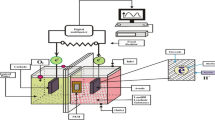Abstract
Microbial fuel cells (MFCs) are a unique technology that takes advantage of bacterial metabolism to generate electricity and remove chemical oxygen demand (COD) from organic pollutants. Existence of heavy metals in fuel affects vitally bacterial activity in MFC. Present study aimed to define the negative effect of three most toxic heavy metals, namely mercury (HgCl2), lead (Pb(NO3)2), and cadmium (CdCl2), on the activity of bacterium Shewanella putrefaciens with respect to electricity generation and COD removal in MFC from food industry wastewater. A central composite rotatable design was employed to determine the significant toxic levels of used heavy metals. The results indicted that the main effect of HgCl2, Pb(NO3)2, and CdCl2 was −62.17, −58.55, and −31.65 %, respectively, with respect to electricity generation, as well as −34.32, −32.25, and −18.95 %, respectively, with respect to COD removal, at 95 % confidence. The statistical design determined the significant toxic levels for each factor of heavy metals alone as (mg/100 mL) HgCl2 23.45, Pb(NO3)2 34.38, and CdCl2 48.31, with respect to electricity generation, as well as 26.34, 31.84, and 52.56, respectively, with regard to COD removal at 95 % confidence. The coefficient of determination (R2) was found to be 0.93 and 0.98 for electricity generation and COD removal, respectively. The confirmatory experiments showed closeness of predicted and observed values.
Similar content being viewed by others
References
Pant, D., Gilbert Van, B., Ludo, D., Karolien, V.: A review of the substrates used in microbial fuel cells (MFCs) for sustainable energy production. Bioreso. Technol. 10, 1533–1543 (2010)
Pant, D., Anoop, S., Gilbert Van, B., Stig, I.O., Poonam, S.N., Ludo, D., Karolien, V.: Bioelectrochemical systems (BES) for sustainable energy production and product recovery from organic wastes and industrial wastewaters. RSC Adv. 2(4), 1248–1263 (2012)
Pepper, I.L., Gerba, C.P.: Environmental Microbiology. 2nd edn. Elsevier, San Diego (2005)
Naaz, S., Pandey, S.N.: Effect of industrial wastewater on heavy metals accumulation, growth and biochemical responses of lettuce (Lactuca Sativa L.). J. Environ. Biol. 31, 273–276 (2010)
Fitzgerald, W.F., Lamborg, C.H.: Geochemistry of mercury in the environment. In: Sherwood Lollar, B., Holland, H.D., Turekian, K.K. (eds.) Environmental Geochemistry, vol. 9, pp. 107–148. Elesvier–Pergamon, Oxford (2003)
Jadhav, U.U., Hocheng, H.: A review of recovery of metals from industrial waste. J. Achiev. Mater. Manuf. Eng. 52(2), 159–167 (2012)
Kim, B.H., Kim, H.J., Hyun, M.S., Park, D.H.: Direct electrode reaction of Fe(lI1)-reducing bacterium, Shewanella putrefaciens. J. Microbiol. Biotechnol. 9(2), 127–131 (1999)
Kim, H.J., Hyun, M.S., Chang, I.S., Kim, B.H.: A microbial fuel cell type lactate biosensor using a metal-reducing bacterium, Shewanella putrefaciens. J. Microbiol. Biotechnol. 9(3), 365–367 (1999)
Kim, H.J., Park, H.S., Hyun, M.S., Chang, I.S., Kim, M., Kim, B.H.: A mediator-less microbial fuel cell using a metal reducing bacterium, Shewanella putrefaciens. Enzyme Microb. Technol. 30(2), 145–152 (2002)
Park, D.H., Zeikus, J.G.: Impact of electrode composition on electricity generation in a single-compartment fuel cell using Shewanella putrefucians. Appl. Microbiol. Biotechnol. 59, 58–61 (2002)
Park, D.H., Zeikus, J.G.: Improved fuel cell and electrode designs for producing electricity from microbial degradation. Biotechnol. Bioengin. 81(3), 348–355 (2003)
Ringeisen, B.R., Henderson, E., Wu, P.K., Pietron, J., Ray, R., Little, B., Biffinger, J.C., Jones-Meehan, J.M.: High power density from a miniature microbial fuel cell using Shewanella oneidensis DSPIO. Environ. Sci. Technol. 40(8), 2629–2634 (2006)
Montgomery, D.C.: Design and Analysis of Experiments. Wiley, New York (2001)
Bezerra, M.A., Santelli, R.E., Oliveira, E.P., Villar, L.S., Escaleira, L.A.: Response surface methodology (RSM) as a tool for optimization in analytical. Talanta 76, 965–977 (2008)
Myers, R.H., Montgomery, D.C.: Response Surface Methodology: Process End Product Optimization Using Designed Experiments. 2nd edn. Wiley, New York (2002)
Vargas, A.M.M., Garcia, C.A., Reis, E.M., Lenzi, E., Costa, W.F., Almeida, V.C.: NaOH-activated carbon from flamboyant (Delonix regia) pods: Optimization of preparation conditions using central composite rotatable design. Chem. Eng. J. 162, 43–50 (2010)
Auta, M., Hameed, B.H.: Optimized waste tea activated carbon for adsorption of Methylene Blue and Acid Blue 29 dyes using response surface methodology. Chem. Eng. J. 175, 233–243 (2011)
Gan, C.Y., Latiff, A.A.: Optimization of the solvent extraction of bioactive compounds from Parkia speciosa pod using response surface methodology. Food Chem. 124, 1277–1283 (2011)
Prasad, K.N., Hassan, F.A., Yang, B., Kong, K.W., Ramanan, R.N., Azlan, A.: Response surface optimization for the extraction of phenolic compounds and antioxidant capacities of underutilized Mangifera pajang Kosterm. Peels. Food Chem. 128, 1121–1127 (2011)
Box, G.E.P., Wilson, K.B.: On the experimental attainment of optimum conditions. J. R. Stat. Soc. Ser. 13(1), 1–38 (1951)
Liu, H., Logan, B.E.: Electricity generation using an air–cathode single chamber microbial fuel cell in the presence and absence of a proton exchange membrane. Environ. Sci. Technol. 38, 4040–4046 (2004)
Clesceri, L.S., Greenberg, A.E., Trussell, R.R.: Standard Methods for the Examination of Water and Wastewater. American Public Health Association (APHA), Washington (1989)
Wei, F.S.: Water andWastewater Monitoring Analysis Method. Publishing House of Environmental Science of China, Beijing (2002)
Chen, J., Tao, X., Xu, J., Zhang, T., Liu, Z.: Biosorption of lead cadmium and mercury by immobilized microcystis aeruginosa in a column. Biochemistry 10(12), 3675–3679 (2005)
Logan, B.E.: Microbial Fuel cells. Wiley, Hoboken (2008)
Jiang, J., Zhao, Q., Zhang, J., Zhang, G., Lee, D.: Electricity generation from bio-treatment of sewage sludge with microbial fuel cell. Biores. Technol. 100, 5808–5812 (2009)
Vainionpaa, J., Malkki, Y.: Extrusion Cooking in the Manufacture of Intermediate Moisture Food and Feed. Singapore Institute of Food Science and Technology, Singapore (1987)
Martin-Gil, J., Ramos-Sanchez, M.C., Martin-Gil, F.J.: Shewanella putrefaciens in a fuel-in water emulsion from the prestige oil spill. Antonie Van Leeuwenhoek 86(3), 283–285 (2004)
Author information
Authors and Affiliations
Corresponding author
Rights and permissions
About this article
Cite this article
Al-Shehri, A.N.Z. Employing a Central Composite Rotatable Design to Define and Determine Significant Toxic Levels of Heavy Metals on Shewanella putrefaciens in Microbial Fuel Cell. Arab J Sci Eng 40, 93–100 (2015). https://doi.org/10.1007/s13369-014-1477-9
Received:
Accepted:
Published:
Issue Date:
DOI: https://doi.org/10.1007/s13369-014-1477-9




